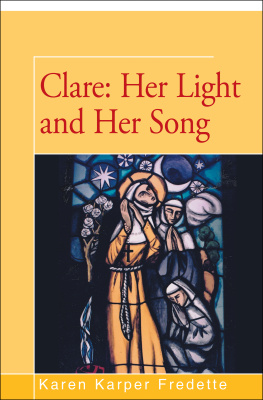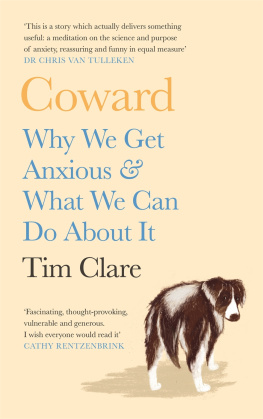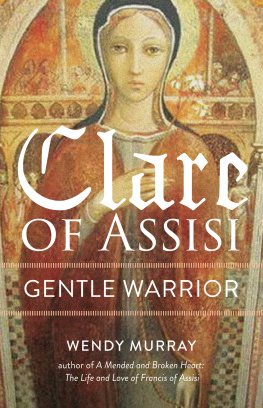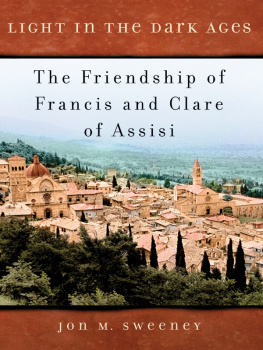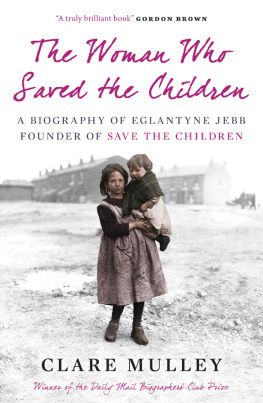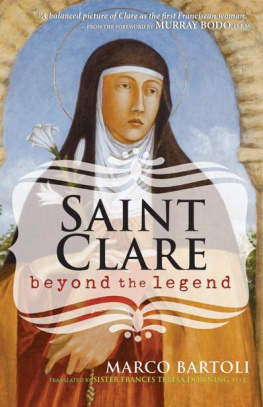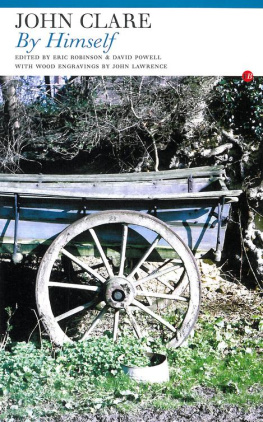Clare: Her Light and Her Song
Karen Fredette
Bright and barefoot on the earth,
the night her mantle light,
Clare appraises all as loss
and sings:
All wonders of the world
are only way for me
my light is Christ!
Warrior woman, strong she fought
for dearest depth of poverty
found within dark flowering
of now and nothing.
All wonders of the world
are only way for me
my wealth is Christ!
Power flowing from a Cross,
resurrection light in Francis limbs,
stirs and steals her song,
bridal-dancer of the Crucified:
All wonders of the world
are only way for me
my Song is Christ!
TO ALL MY POOR CLARE SISTERS
ESPECIALLY
TO THOSE NEAREST AND DEAREST
WITH WHOM I DAILY SHARE
THE DISCOVERY AND DEEPENING OF CLARES
DREAM,
THIS WORK IS GRATEFULLY DEDICATED.
HOW THIS WORK HAPPENED
After Vatican Council II issued its call to all communities to rediscover the charism of their founder/foundress, I realized that my conception of St. Clares charism was decidedly thin. In fact, she herself was a very hazy figure in my mind, more of a name than a living person whose dream I was supposed to be incarnating in the twentieth century.
So in the mid-sixties I began asking the question and seeking the answers which have led me on a course of exciting discoveries about this marvelous woman named Clare. Gradually material gathered from diverse sources began to flesh out the life, the times, and the personality of Clare di Favarone, daughter of one of the noblest houses of Assisi. I encountered a woman who was one of the most well known figures in the Church and Europe in her own century and who was described at her death as the new captain of womankind.
At that time (1253) over one hundred monasteries of women following her way of life were flourishing in Europe. Clare was the first woman to write her own Rule and obtain Papal approbation for it. She guarded the original inspiration of St. Francis with more energy and tenacity than did most of the Friars during the tumultous years directly following Francis death in 1226.
This was a woman I wanted to knowas intimately and clearly as the seven-hundred year gap between her life and mine would permit. Although there are not too many documents deriving directly from Clare or writings about her by contemporaries, there are sufficient to piece together a chronological development of her life, lived at the heart of the brilliant thirteenth century.
I also had the inestimable advantage of learning and writing about Clare from the inside out; that is, from within a cloister where her Rule and spirit were the guiding norm of daily life. This work is only a pioneering venture, a beginning of what can and, hopefully, will be written about Clare in the years to come.
I have attempted to write not only Clares life-story but something of her dream, her song. I have tried to capture in some small measure a hint of the Light she became, a reflection of that Light which came into the world to illumine the hearts of all who would receive Him.
My gratitude for assistance with this project of many years extends to innumerable persons, especially to those many who prayed with me and for me for the successful completion of this work. First of all, I wish to thank my own community of Sancta Clara. My sisters have not only shown me many facets of Clares light but have also supported me, believed in me, and encouraged me. They have learned to possess their souls in patience as they listened to portions of this manuscript in early drafts and have made valuable contributions and offered constructive criticisms.
Beyond the cloister walls, I must acknowledge my deep gratitude to Sister Madge Karecki S.S.J.-T.O.S.F. who read the manuscript chapter by chapter and shared her scholarship and insights with me generously.
I wish also to thank my many Franciscan brothers who have assisted me by making the fruits of their research available. Among these are Fathers Conrad Harkins O.F.M., Bernardine Beck O.F.M., Caesar van Hulst O.F.M., Regis Armstrong O.F.M.Cap., and Brother Charles McCarron O.F.M.Cap. I want to mention the assistance given to me by many Poor Clare sisters in other communities, especially Sisters Dolores Steinberg O.S.C. and M. Michael O.S.C.
Valuable information about Assisi and its environs has been given to me by many friends who have visited the city of Francis and Clare and who related to me their visual and felt impressions of this homeland of all Franciscans.
Last of all, I feel I should thank my own family whose loving support, interest, and encouragement have heartened me to continue the work. The prayers of my loving parents, brothers, and sister, their spouses, my nieces and nephews, aunts and uncles, cousins of first, second and third degree, including Tommy who asked for special mention, have helped me to understand and write about Clare who also enjoyed the grace of an extended family.
To all these and so many more, I pray that Clare will grant a share in her love and joy in the Lord.
August 11, 1983
Preface
Though St. Clare is rightly called the most faithful follower of St. Francis, relatively few people know of the stature of her personality or the wisdom of her spiritual teaching. It has only been within the last thirty years that her writings have become available to the English speaking world. Biographies of Clare have, for the most part, been more the product of the individual authors musings than of painstaking research.
Clare di Favarone of the Offreduccio family emerged from what sociologists call a closed social system as a source of true liberation for men and women of her day. Her spirit would not be constricted by the rigid boundaries of life in the Middle Ages. She became attracted to a style of gospel living articulated by Francis of Assisi, son of the wealthy clothier, Pietro Bernardone, despite the differences in their social and economic status. Together they form the two great lights of the Franciscan family shedding their light upon their brothers and sisters for the past seven centuries.
Clare was captivated by the Poor Christ much as Francis was during his lifetime. Though she had to live the last twenty-seven years of her life without the support of her soul-friend, her fidelity to walking in the footprints of Jesus was undiminished. Poverty was the context of her life and her spiritual teaching.
Clare so treasured poverty that she procured the Privilege of Poverty from Innocent III and had it renewed by Gregory IX. This document freed forever the Poor Ladies of any constraint to accept property or other material security that would insure for them regular income. This was unheard of in the history of the Church.
As is evident from her example and her writings Clare taught that poverty made her and her sisters wholly dependent on God. Material poverty was the framework and foundation for her prayer and contemplation. She wrote these words of praise for poverty to her friend Agnes of Prague:
What a great laudable exchange:
to leave the things of time for those of eternity,
to choose the things of heaven for the goods of earth,
to receive the hundred-fold in place of one,
and to possess a blessed and eternal life.
This letter written in the early 1230s is as challenging to us of the twentieth century as it was to the medieval Agnes, all of us journeying to the kingdom of God.
Sister M. Karens biographical study of Clare of Assisi brings the light of this medieval woman into prominence for us and thus serves us well. For in looking to the light of Clare and listening to her message we find direction and aid as we too endeavor to follow in the footprints of Jesus.

